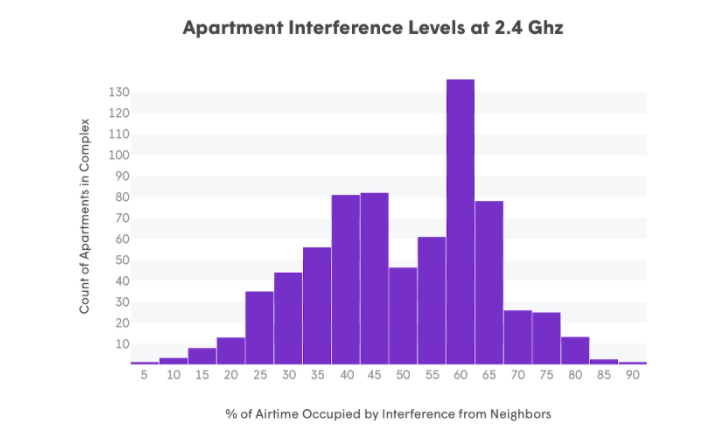Combatting throughput loss in MDUs
Read time: 4 minutes

Can a “mesh” consist of just a single access point (AP)? Yes! Consider a multi-dwelling unit (MDU) with a single Wi-Fi access point in each apartment. While these APs don’t explicitly connect to each other, they do affect each other. Plume Adaptive WiFi™ has been architected to address the challenge of delivering a high Quality of Experience (QoE) in densely populated environments including apartment complexes - something you don’t get with static mesh solutions.
Figure 1 below, taken from a typical large apartment complex, shows the extent of the problem. Interference from neighboring apartments is taking more than 45% of the airtime from half of the apartments. The people in these homes are losing nearly half of their available throughput, nearly doubling the time to download content, and increasing the odds that video will stall or stutter. Also note that some apartments have it even worse, losing nearly 70% of their airtime and having to get by with just over 30% of the data rates they are paying for.
Figure 1 - Histogram showing the distribution of interference within individual apartments in the same complex

Such locations can’t be considered independent of one another, and shouldn’t be managed independently either. They are (en)meshed!
But that is just the problem. Some Wi-Fi systems ignore changes in interference from neighbors entirely. At best, traditional Wi-Fi systems watch the interference from neighboring homes and make independent, un-coordinated changes, locally decided for each apartment, paying no attention to the effect those changes will have on the apartments around them. Chaotic and ineffective assignment of frequency channels within an MDU is very complicated to manage even when Wi-Fi is supplied from a single carrier who has the control to address the issue. There is a better way...
To optimize the performance in all apartments they need to be considered together, with the interference that they inflict on each other considered similar to the connections of a mesh. Plume’s Adaptive WiFi does just this. Each AP delivers measured statistics regarding interference and traffic loads to the cloud. Each AP also indicates the other APs it can hear, and the signal strength of each. Plume optimizes channel selection at each AP in the cloud, considering the entire apartment complex as a whole. Plume factors which APs interfere with other APs, at what signal levels, and the traffic load at each AP, then chooses an overall configuration that maximizes the throughput that can be achieved across all the apartments.
The result is a configuration that cannot be obtained by traditional “mesh” systems. The advantages of a centralized cloud-controlled approach for a “mesh of single APs” include:
Greater stability: When there is independent control in each apartment, one AP can make a change, thereby changing the interference it throws into its neighbors. This induces its neighbors to make changes. The process can continue indefinitely, the changes rattling around the apartment complex in asynchronous instability. In Adaptive WiFi, the cloud calculates the ideal arrangement for the entire apartment complex once and deploys it. The configuration will stay constant; stably waiting for the next time the controller decides an update is justified. Predictable, controlled, optimum. Isn’t that how you want your Wi-Fi to be?
Higher average throughputs: By considering the apartment complex as a whole, the Adaptive WiFi cloud controller can choose the best possible arrangement of channel frequency and bandwidths to maximize the throughput of the entire system. Such a global optimum cannot be reached if each AP chooses channels with only their own local knowledge. Consider the difference in controlling a traffic light based just on what is going on at that light, compared to controlling it based on the traffic and light states across the entire city.
QoE: The Adaptive WiFi cloud controller factors not only which APs hear which other APs, but also the traffic loads that each apartment is placing on the overall system. By factoring the load as well as the interference, apartments with video streams or other high bandwidth critical data streams can be protected from the sporadic interference of low data rate, low priority traffic. Putting express trains on separate tracks from local trains is an efficient principle for Wi-Fi too!
Like it or not, even if you have a single AP in your home, it’s probably (en)meshed. Last month’s blog described how a cloud-based management system benefited mesh networks. It is no different with a mesh created by interference. For stability, high throughputs, and better QoE, cloud-based Adaptive WiFi is the best approach for homes with multiple APs, or just one AP.